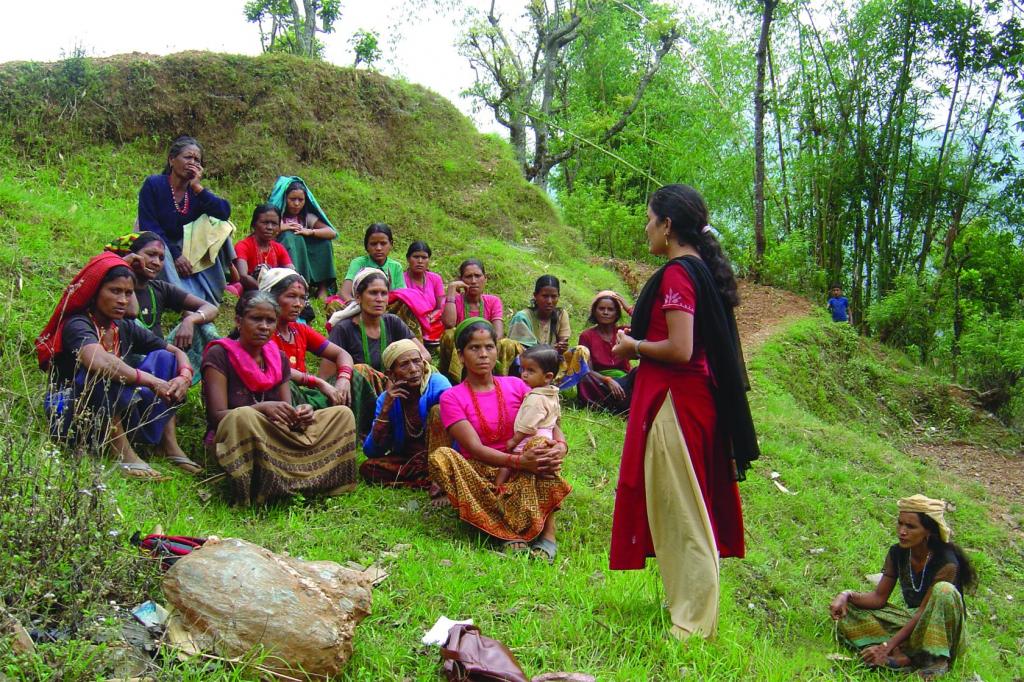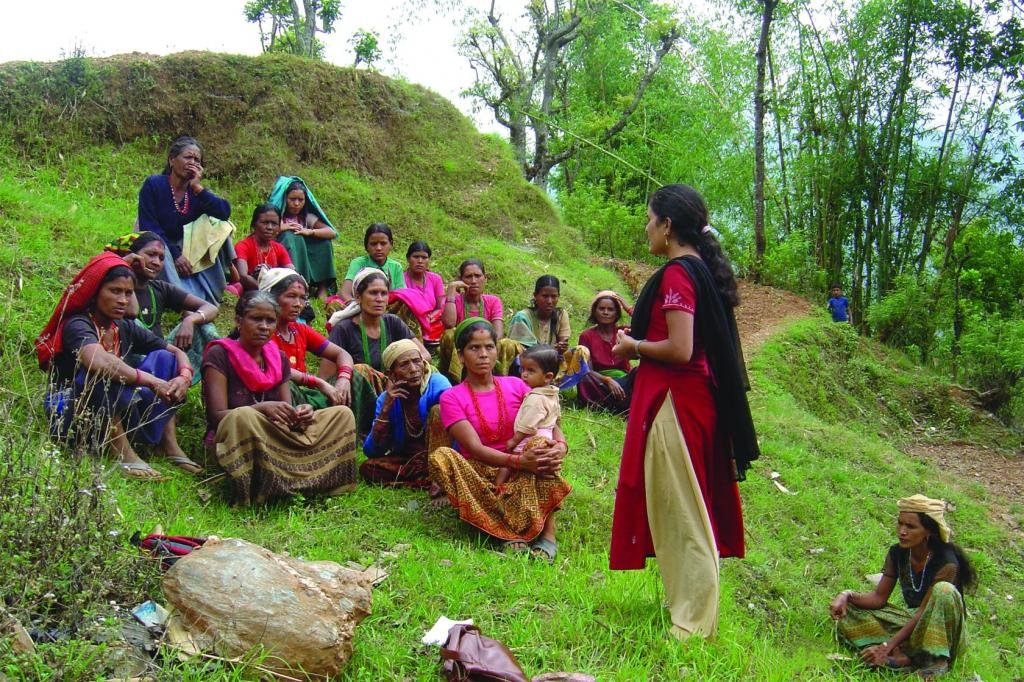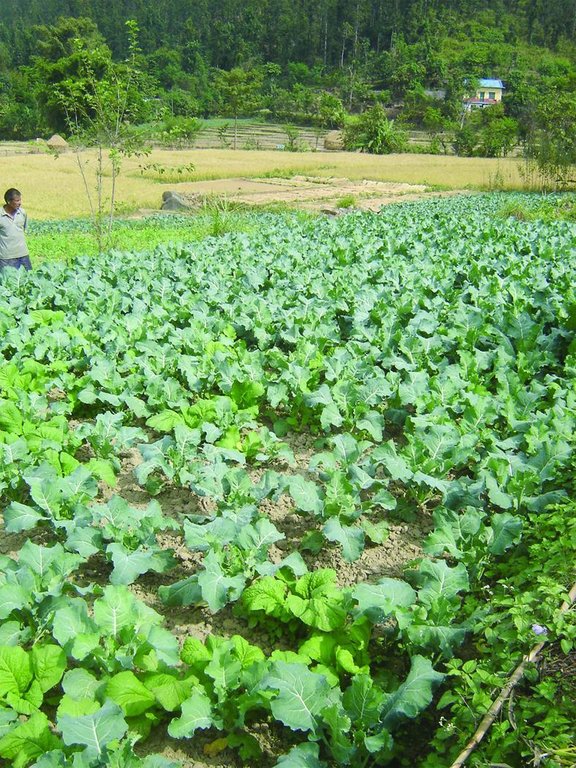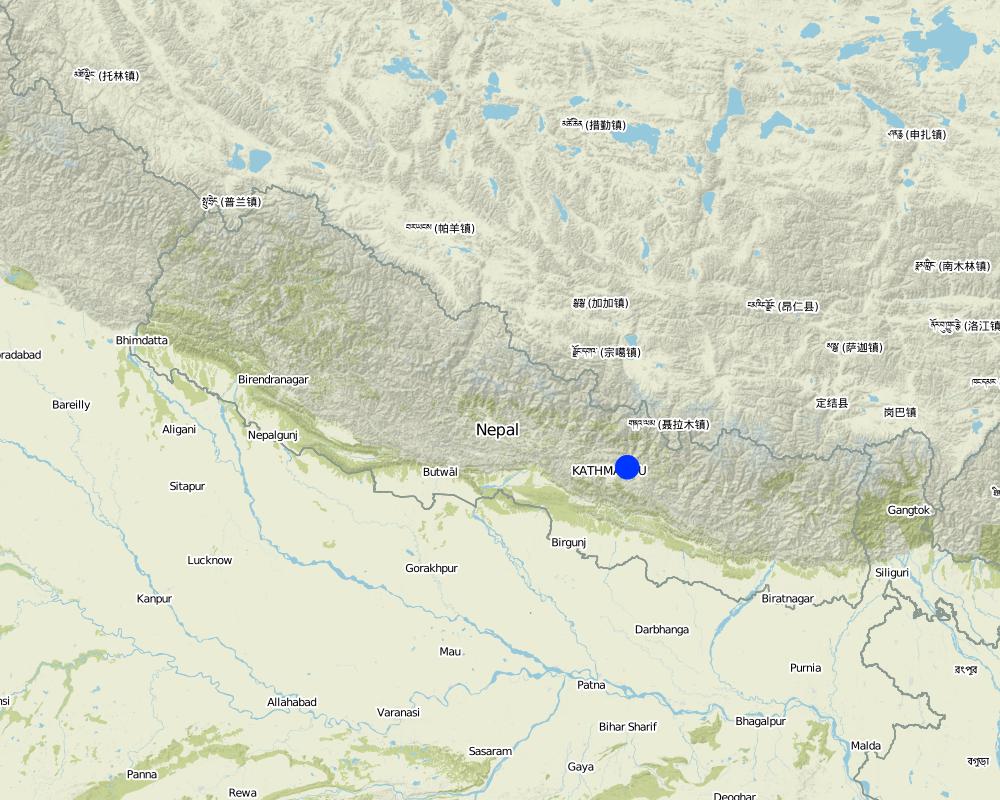Farmer-led experimentation [Непал ]
- Шинийг нээх:
- Шинэчлэх:
- Мэдээлэл цуглуулсан: Richard Allen
- Редактор: –
- Хянагч: Laura Ebneter
Krishak ko aguwai ma garine parikshan (Nepali)
approaches_2559 - Непал
Бүлгүүдийг үзэх
Бүгдийг харуулах Бүгдийг хаах1. Ерөнхий мэдээлэл
1.2 Арга барилыг баримтжуулах болон үнэлгээ хийхэд оролцсон хүн эсвэл байгууллагын холбоо барих хаяг
ГТМ мэргэжилтэн :
Soil Management Directorate
+977 1 5520314
Department of Agriculture
Harihar Bhawan, Lalitpur
Непал
ГТМ мэргэжилтэн :
Team Leader Sustainable Sustainable Soil Management Programme (SSMP)
+977 1 5543591
ssmp@helvetas.org.np
Sustainable Soil Management Programme (SSMP)
GPO Box 688, Kathmandu
Непал
Арга барилыг баримтжуулах/үнэлэх ажилд дэмжлэг үзүүлсэн төслийн нэр (шаардлагатай бол)
Sustainable Soil Management Programme, Nepal (SSMP)Арга барилыг баримтжуулах/үнэлэх ажилд дэмжлэг үзүүлсэн байгууллага(ууд)-ын нэр (шаардлагатай бол)
HELVETAS (Swiss Intercooperation)1.3 WOCAT-аар баримтжуулсан өгөгдлийг ашиглахтай холбоотой нөхцөл
Эмхэтгэгч болон гол мэдээлэгч хүн(хүмүүс) WOCAT аргачлалаар баримтжуулсан мэдээллийг ашиглахтай холбоотой нөхцлийг хүлээн зөвшөөрсөн.
Тийм
1.4 ГТМ-ийн технологийн асуулгын(д) суурь мэдээлэл(д)
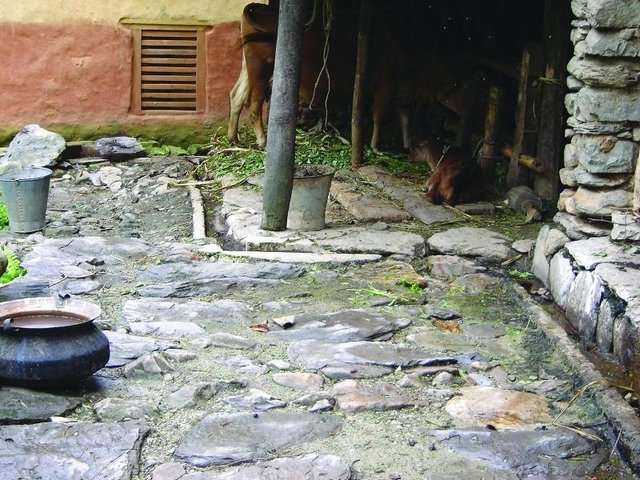
Improved cattleshed for urine collection [Непал ]
Collection of cattle urine in improved cattle sheds for use as liquid manure and organic pesticide
- Мэдээлэл цуглуулсан: Richard Allen
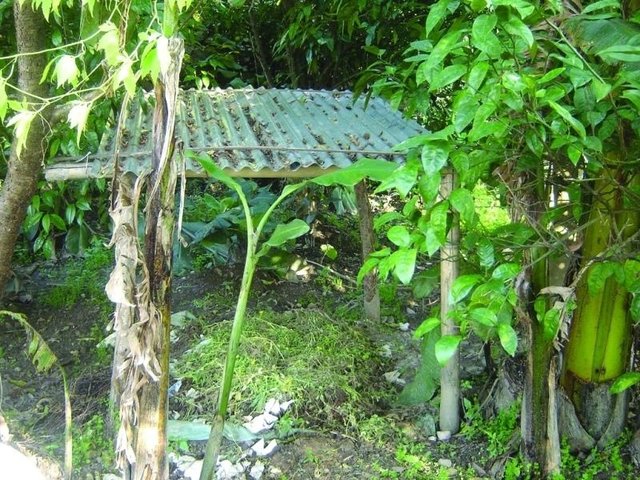
Improved compost preparation [Непал ]
Improved compost preparation using a range of biomass and waste to produce high value fertiliser
- Мэдээлэл цуглуулсан: Richard Allen
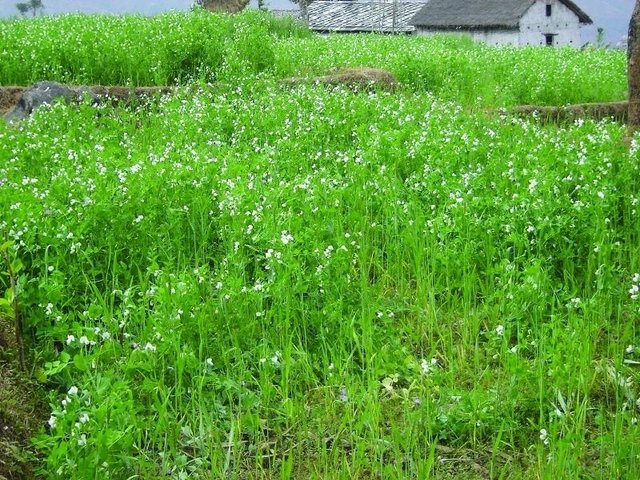
Legume integration [Непал ]
Integration of leguminous crops as intercrops on terrace risers or as relay crops
- Мэдээлэл цуглуулсан: Richard Allen
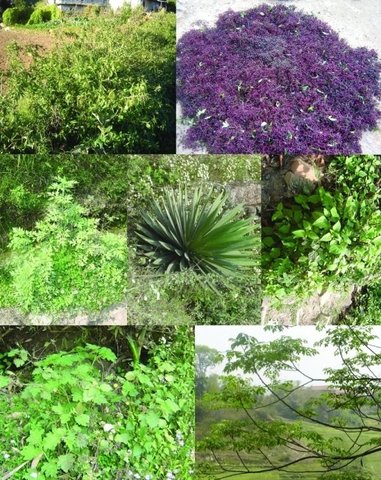
Organic pest management [Непал ]
Promotion of botanical pesticides for organic pest management and liquid manure
- Мэдээлэл цуглуулсан: Richard Allen
2. ГТМ Арга барилын тодорхойлолт
2.1 Арга барилын товч тодорхойлолт
Participatory technology testing and adaptation through farmer-led experiments
2.2 Арга барилын дэлгэрэнгүй тодорхойлолт
Арга барилын дэлгэрэнгүй тодорхойлолт :
Farmer-led experimentation is a type of action research initiated and carried out by farmers in their own fields. This approach enables farmers to identify technological options suited to local agroecological and socioeconomic conditions. The farmer-led experimentation process is taken up within existing farmer groups. This approach is closely related to the 'participatory innovation development' and the 'participatory technology development' approaches as discussed in Kolff et al. (2005). Simple experiments are usually replicated in five to ten farmers' fields per group. Generally, the whole of each experimental plot from each field is harvested and the yield recorded. Field implementation, group visits, and observations are carried out by the farmers themselves. The processing of results is done in groups together with the support staff from the facilitating organisation. These farmers are very likely to adopt tested technologies that are shown to be better for meeting their needs. The results are also used by support staff and shared with other organisations, and provide input for dissemination through farmer-to-farmer diffusion.
Farmers play a leading role in all steps of the process, starting from problem identification to planning, implementation, and evaluation of the experiments. This ensures that farmers are the driving force in the research process and not mere recipients of research findings that have been generated elsewhere. The detailed implementation plan is discussed within the groups and individual and collective responsibilities are assigned. The experimental site, individual implementing farmers, group visits, and results-sharing meetings are decided on by group consensus. Some observations are recorded by the implementing farmers. Promising innovations are then identified based on the collective evaluation of the tested treatments. Technical and other facilitation support is provided by organisations active in the area.
2.3 Арга барилын зурагууд
2.5 Арга барил нэвтрүүлсэн улс орон / бүс нутаг / байршил
Улс :
Непал
Улс/аймаг/сум:
Midhills
Map
×2.7 Арга барилын төрөл
- төсөл / хөтөлбөр дээр үндэслэсэн
2.8 Арга барилын үндсэн зорилго, зорилтууд
Local farmers collectively solving problems by identifying and using the most appropriate local solutions. Local farmers designing, testing and disseminating alternative technologies adapted to local conditions. Strengthening joint learning by farmers and development actors.
The SLM Approach addressed the following problems: The common issues concerning farmers in growing crops include pests and diseases, yield decline, inappropriate crop varieties, and the introduction of new varieties. Rather than technicians providing farmers with ready-made solutions to their problems (that may or may not work), farmer-led experimentation allows farmers to carry out their own trials to try and solve specific problems.
2.9 Арга барилын хүрээнд хэрэгжсэн Технологи/Технологиудад дэмжсэн эсвэл саад учруулсан нөхцлүүд
санхүүгийн нөөц, үйлчилгээний хүртээмж / боломж
- Хазаарлалт
Lack of money for technical support
Treatment through the SLM Approach: Collaborative approach amongst farmers from the same settlements
Бүтэц зохион байгуулалт
- Хазаарлалт
Dysfunctional government extension system
Treatment through the SLM Approach: Reliance on local human resources and farmer to farmer collaboration
ГТМ-ийн талаарх мэдлэг, техникийн дэмжлэг авах боломж
- Хазаарлалт
Problems related to agricultural production and soil fertility
Treatment through the SLM Approach: esting and adaptation of technologies to local conditions using local human and natural resources
3. Оролцогч талуудын оролцоо ба үүргүүд
3.1 Арга барилд оролцогч талууд болон тэдгээрийн үүргүүд
- Орон нутгийн газар ашиглагч / орон нутгийн иргэд
3.2 Арга барилын янз бүрийн үе шатанд орон нутгийн газар ашиглагчид / бүлэглэлүүдийг татан оролцуулах
| Орон нутгийн газар ашиглагч / орон нутгийн иргэдийн оролцоо | Хэн оролцсоныг тодорхойлж, үйл ажиллагааг тайлбарлана уу | |
|---|---|---|
| санаачлага/идэвхжүүлэлт | интерактив | participatory discussions and exercises, field visits, farm maps, farming and labour calendar, Activities: Identification of topics for experiment based on needs and priority, Identification of technological options (indigenous and external), Farmers developing simple and appropriate experiments, De |
| Төлөвлөгөө | үгүй | |
| Хэрэгжилт | интерактив | follow-up visits, discussions, Activities: Farmers implement according to the design for comparison with a control (= existing practice), Farmers note relevant observations on recording sheet. Farmers note other important observations based on their needs and interests, Technical support and discuss |
| Мониторинг/ үнэлгээ | интерактив | field visit to experimental site by other farmers, participatory discussion and evaluation Activities: Experimenting farmers and other farmers jointly discuss and evaluate based on direct observations of the trial and from the record sheet, Discussion on the lessons learned and identifying possible |
| Research | үгүй |
3.4 ГТМ-ийн технологи/технологиуд сонгох шийдвэр
Хэрэгжүүлэх Технологи/Технологиудын сонголтыг хийж шийдвэр гаргасан хүнийг тодорхойлно уу:
- Газар ашиглагч дангаараа (өөрийн санаачлага)
Тайлбар :
Made collectively by farmers in group facilitated by organisation working with them.
Decisions on the method of implementing the SLM Technology were made by by land users* alone (self-initiative / bottom-up). Made by farmers in group
4. Техникийн дэмжлэг, чадавхи бүрдүүлэх, мэдлэгийн менежмент
4.1 Чадавхи бэхжүүлэх/сургалт
Газар эзэмшигчид / бусад оролцогч талуудад сургалт явуулсан уу?
Тийм
Хэн сургалтанд хамрагдсан бэ:
- Газар ашиглагчид
4.3 Институцийг бэхжүүлэх (байгууллагын хөгжил)
Арга барилаар дамжуулан институц байгуулагдаж эсвэл бэхжсэн үү?
- Тийм, дунд зэрэг
Байгууллагууд бэхжиж, үүсэн бий болсон түвшин(үүд)-г тодорхойлно уу:
- Орон нутгийн
Дэлгэрэнгүй мэдээллийг өгнө үү:
Technical support provided by project
4.4 Мониторинг ба үнэлгээ
Мониторинг болон үнэлгээ нь арга барилын хэсэг үү?
Тийм
Тайлбар:
bio-physical aspects were monitored by land users through observations
technical aspects were monitored by land users through observations
economic / production aspects were monitored by land users through observations
area treated aspects were monitored by land users through observations
land users involved aspects were monitored by land users through observations
management of Approach aspects were monitored by land users through observations
There were several changes in the Technology as a result of monitoring and evaluation: The adoption of certain technologies has occurred as a result of farmer-led experimentation. For example, a farmer-led trial of two varieties of groundnut (local and B4), in Ghadgaon, Surkhet, led to farmers starting to grow the B4 variety in an area where previously only local varieties had been growing
5. Санхүүгийн болон гадаад материаллаг дэмжлэг
5.1 ГТМ-ийн Арга барилын бүрэлдэхүүн хэсгийн жилийн төсөв
Тайлбар (жнь: санхүүжилтийн гол эх үүсвэр / гол хандивлагчид):
Approach costs were met by the following donors: local community / land user(s) (local resources, labour, land): 50.0%; other (Dev. project(inputs, external resources)): 50.0%
5.2 Газар ашиглагчдад санхүүгийн / материаллаг дэмжлэг үзүүлсэн
Технологи / технологийг хэрэгжүүлэхэд газар ашиглагчид санхүүгийн / материаллаг дэмжлэг авсан уу?
Тийм
Хэрэв тийм бол дэмжлэгийн төрөл(үүд), нөхцөл, болон нийлүүлэгч(чид) бичнэ үү:
Provided by the project for testing purposes
5.3 Тодорхой зардлыг даахад чиглэсэн дэмжлэгт (хөдөлмөрийн хүчийг оролцуулаад)
Хэрэв газар ашиглагчийн хөдөлмөрийн хүч чухал байсан бол энэ нь аль хэлбэр байсан:
- сайн дурын
6. Нөлөөллийн дүн шинжилгээ ба дүгнэлт
6.1 Арга барилын нөлөөллүүд
Арга барил нь ГТМ-ийн технологийг хэрэгжүүлж, хадгалахад газар ашиглагчдад тусласан уу?
- Үгүй
- Тийм, бага зэрэг
- Тийм, зарим
- Тийм, их
Great impacts on soil fertility and yields have been reported after the adoption of sustainable soil management tested through farmer-led experimentation.
Did other land users / projects adopt the Approach?
- Үгүй
- Тийм, бага зэрэг
- Тийм, зарим
- Тийм, их
Several farmers in the project area have started to do farmer-led experiments on their own, including on intercropping different vegetables and spices, and on urine application through drip irrigation
6.3 Арга барилын үйл ажиллагааны тогтвортой байдал
Газар ашиглагчид арга барилаар дамжуулан хэрэгжүүлсэн арга хэмжээг тогтвортой хадгалж чадах уу (гадны дэмжлэггүйгээр)?
- Тийм
Хэрэв тийм бол яаж гэдгийг тайлбарлана уу:
Some farmers are implementing the approach on their own initiative. This is possible because of the low costs and limited technical requirements of the approach. Farmers exposed to the approach will be able to apply the approach again to problems that arise in their fields without the need to consult outside agencies.
6.4 Арга барилын тогтвортой/давуу тал/боломжууд
| Эмхэтгэгч, бусад мэдээлэл өгсөн хүмүүсийн өнцгөөс тодорхойлсон давуу тал/боломжууд |
|---|
| The approach serves both as a local test for suitability and adaptation potential as well as for demonstrating an already tested technology. |
| Once farmers are exposed to the approach, they can apply it on their own initiative. This is possible because of the low costs and technical requirements of the approach. |
| Experiments are conducted on the basis of farmers' priorities and according to local conditions. This means that farmers develop ownership of the experiments and the derived results. |
6.5 Арга барилын дутагдалтай/сул тал/аюул болон тэдгээрийн хэрхэн даван туулах арга замууд
| Эмхэтгэгч, бусад мэдээлэл өгсөн хүмүүсийн өнцгөөс тодорхойлсон сул тал/ дутагдал/ эрсдэл | Тэдгээрийг хэрхэн даван туулах вэ? |
|---|---|
| Experiments are not carried out in a scientifically rigorous way and therefore only have limited scientific value for evaluating technologies. | if scientific proof is required, farmer-led experiments should be closely supported by technicians (per se not a farmer-led experiment anymore!) |
| Documentation of the activities and results for wider sharing is often poor and inadequate | clear guidelines are needed for documentation with clear instructions on what, when, and how to record important information. This is necessary so that the results can be more widely used. |
| In some cases a lack of research equipment for better documentation and observation inhibits better understanding. |
7. Суурь мэдээлэл болон холбоосууд
7.1 Мэдээллийн эх үүсвэр/аргууд
- Хээрийн уулзалт, судалгаа
- Газар ашиглагчтай хийсэн ярилцлага
7.2 Холбогдох бүтээлийн ишлэл
Гарчиг, зохиогч, он, ISBN:
SSMP (2001) Implementation Guideline on Farmer Led Experimentation (in Nepali). Kathmandu: Sustainable Soil Management Programme
Хаанаас авч болох вэ? Зардал?
SSMP
Гарчиг, зохиогч, он, ISBN:
Paudel, C.L.; Regmi, B.D.; Schulz, S. (2005) - Participatory Innovation Development - Experiences of the Sustainable Soil Management Programme
Гарчиг, зохиогч, он, ISBN:
..In Kolff, A.; van Veldhuizen, L.; Wettasinha, C. (eds) Farmer-centred Innovation Development - Experiences and Challenges from South Asia, pp. 109-126. Bern:
Хаанаас авч болох вэ? Зардал?
SSMP
Холбоос ба модулууд
Бүгдийг харуулах Бүгдийг хаахХолбоосууд

Improved cattleshed for urine collection [Непал ]
Collection of cattle urine in improved cattle sheds for use as liquid manure and organic pesticide
- Мэдээлэл цуглуулсан: Richard Allen

Improved compost preparation [Непал ]
Improved compost preparation using a range of biomass and waste to produce high value fertiliser
- Мэдээлэл цуглуулсан: Richard Allen

Legume integration [Непал ]
Integration of leguminous crops as intercrops on terrace risers or as relay crops
- Мэдээлэл цуглуулсан: Richard Allen

Organic pest management [Непал ]
Promotion of botanical pesticides for organic pest management and liquid manure
- Мэдээлэл цуглуулсан: Richard Allen
Модулууд
Модуль байхгүй байна


